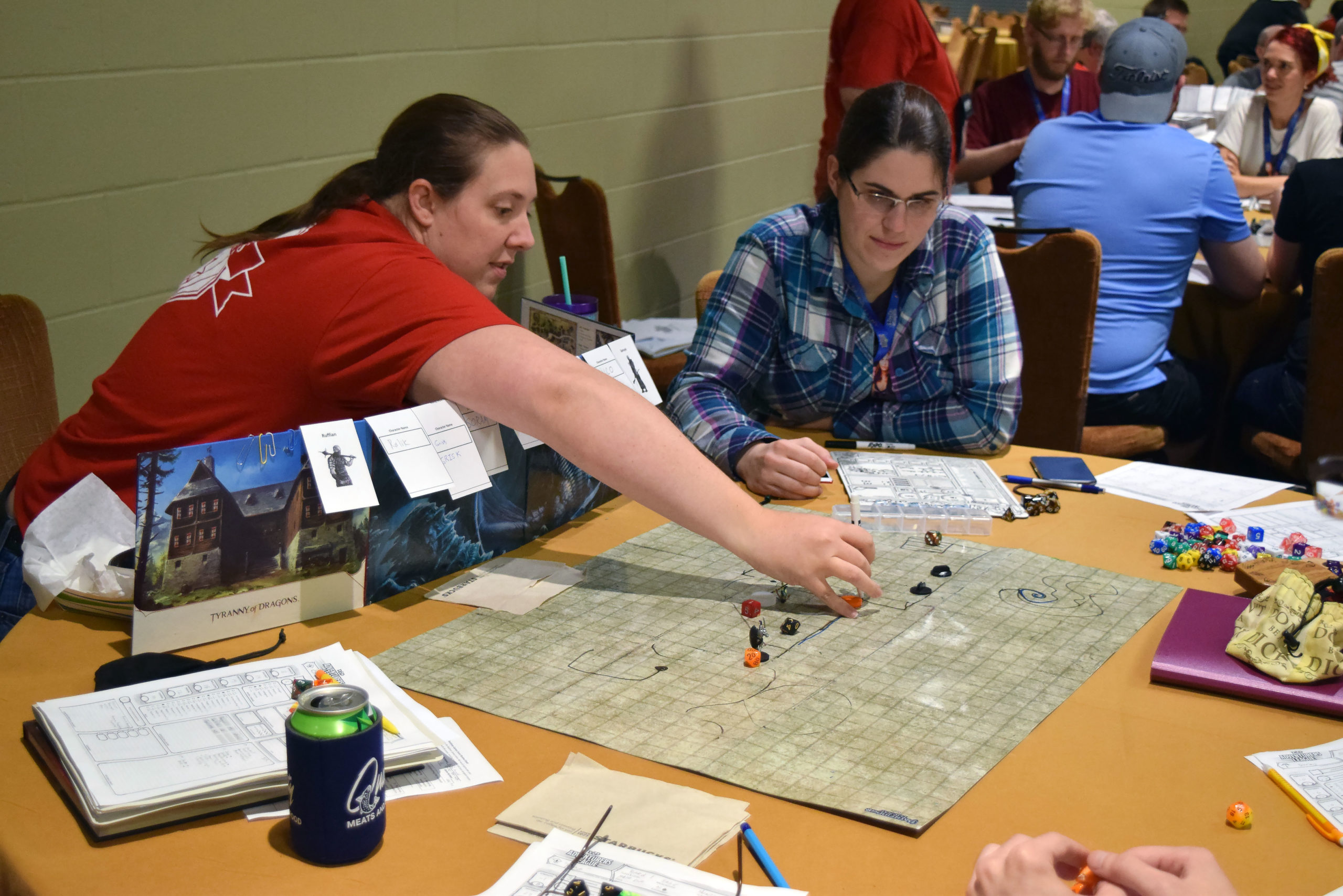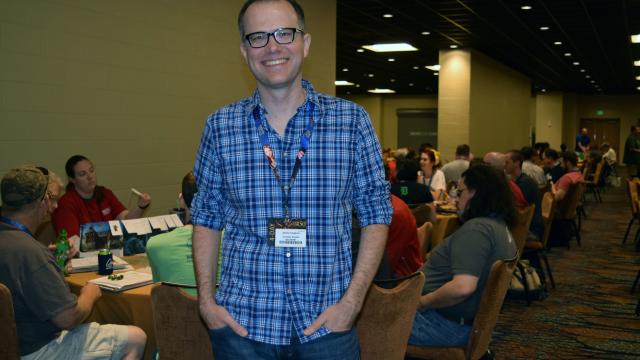Wizards of the Coast’s Jeremy Crawford
Dungeons & Dragons‘ lead rules designer Jeremy Crawford has a tough job. To keep the game in top form, he’s got to make sure its exhaustive ruleset walks that fine line between combat and role-play, thoroughness and accessibility, firmness and flexibility. Along the way, he’s come up with some good tips on getting in touch with D&D‘s system.
D&D‘s rules are a kinetic thing, and in the hands of players and their dungeon master, more kinetic still. Everything is up for interpretation — sometimes, the rules even say so. Occasionally, the rules can use some helping-along with outside tools and unintuitive strategies. And as a lot of players know, sometimes following the rules isn’t even the right thing to do.
At Indianapolis tabletop convention Gen Con, Crawford helped guide Kotaku through his favourite forgotten D&D rules, hacks, and add-ons for fresh players and veterans alike.
Re-jigger ability roles to fit what your character is good at.
A small and hidden rule in the Player’s Handbook cracks open party roles so players stop getting pigeon-holed: mix-and-matching ability scores and skills you’re proficient in. “A lot of people think, for instance, ‘Oh, whenever I use Persuasion, it’s always paired with Charisma,” Crawford said. But in fact, he said,, there’s a variant rule that lets players pair any skill they’re proficient in with any ability score, depending on what’s happening in the story.
“If somebody, for instance, is trying to persuade somebody, they can do it with a kind of acrobatics routine. I might say, all right, give me a Dexterity/Persuasion check,” Crawford explained.
Players, he said, can just add their ‘Proficiency’ bonus to whatever ability bonus is relevant to what they’re trying to do. This opens up characters who might not typically be persuasive to taking the lead in those scenarios.Perhaps highly charismatic characters could talk their way through a successful sleight of hand, which would typically be a Dexterity check, not Charisma.

To keep combat moving along, hang Initiative markers on your Dungeon Master’s screen.
If you’ve ever seen an Adventurer’s League dungeon master hang bits of paper over the top of their dungeon master’s screen, you know this hack. Initiative sequences can get clogged, and a lot of the time, that’s because players aren’t paying attention or don’t know when it’s their turn to fight. Fold a piece of paper in half with each person’s name on it, along with each of the monster groups. “The player-facing side can have players’ names, but on the DM’s side, [players’] passive perception and armour class,” Crawford adds.
Get better technology.
My setup for a Dungeons & Dragons game includes a pencil, a notebook, a Player’s Handbook, a Monster’s Manual, the adventure in question, and my dice. Not very high-tech. When I prepare for a campaign, I’ll use a word processor. It’s not a very organised way of doing things.
Crawford suggests using Microsoft OneNote, a note-taking app available on Mac, PC, iPhone, iPad and Android that stores notes in the cloud. That way, any time you have an idea for your campaign or character, you can jot it down and view it anywhere. Also it’s easy to add sections, pictures and shortcuts there, too, for maximum organisation.

Dice at Gen Con
Weed out problem players before they become a problem.
OK, so this isn’t exactly a rule, but it’s definitely a helpful guideline. Sometimes, you’re stuck with players who aren’t fun to play with. D&D is supposed to be fun. That means you’ve got a problem. And the solution to the problem is to impose a sort of “trial period” on unknown quantities.
“Often, the best way of course is to weed them out before they come,” Crawford said. “Whenever you are considering starting a campaign and you’re thinking about including people you don’t know, it’s best to run a one-shot first, get a feel, and then see about launching the campaign.”
When in doubt, Dodge it out.
When all your party mates have had a go at the goblin, but you’re not sure whether you want to hit it with your broadsword or ready an action or run away or do a little dance, you don’t have to make some complicated strategic calculation. A lot of people don’t realise that you can just “Dodge.”
“When you don’t know what you’re gonna do: Dodge. When you dodge, every attack roll against you has disadvantage,” Crawford said. “I notice that a lot of players don’t realise that action exists.”
Stop rolling monsters’ initiative.
Hiding in the Dungeon Master’s Guide is a tip for cutting down on excessive rolls before combat: “Just assume every monster rolled a 10 on the d20 and make their initiative 10 plus their dexterity modifier,” Crawford said. He and his colleagues over at publisher Wizards of the Coast even considered adding that base initiative score to each monster’s entry in the Monster Manual.

Gen Con
Backgrounds are for “spice,” not hard and fast rules.
When making a character, it’s tempting to go by-the-book in all aspects, including guidelines for that character’s backstory. With 5th edition’s introduction of “Backgrounds,” specific backstories that add proficiencies and grant items, I’ve noticed a lot of players cramming their story ideas into some pretty restrictive stereotypes so they “qualify” for those bonuses. How about simply not doing that?
“Right at the beginning of the backgrounds section, we have a rule there that basically tells you that you can actually ignore all the backgrounds,” Crawford said. “If you want, give yourself whatever two skill proficiencies you want and whatever other elements it says you can give yourself, so you can create the set of characteristics that makes the most sense for your character… Backgrounds are really just meant to give some spice to your character.”
Watch out for players who want to be evil.
The bottom line when it comes to adding evil players to the party is maybe don’t. If a player is dead set on it, and the dungeon master believes they can role-play responsibly and not derail the game, Crawford recommends reminding players that “even bad guys need to have friends, or at least allies they can exploit.
I caution people who play evil characters against screwing over their friends too much.” He also noted that it’s good for the dungeon master to ensure there’s a common purpose among the whole group, or at least relatively adjacent individual goals.
Avoid DM burnout.
When I’m DMing, I often spend just as long preparing for a game as my players do playing it. And, yeah, that has definitely led to burnout. Crawford has a rule for this: “Preparation for any individual session should take no longer than half that session’s length.”
Also, to cut down on future preparation time, DMs should recycle aspects of the game players heedlessly skip over in their rush to advance the story or raid the orc den. “I try to make it so that none of my preparation goes to waste,” Crawford adds.

Comments
8 responses to “D&D Rules Developer’s 9 Insider Hacks For Players And DMs”
Don’t forget. For GMs/DMs, Officeworks is your best gaming store.
Also, never be ashamed to reskin a monster’s stats for something else.
I have had to boot a couple of players for being purely evil characters; they never seem to understand that a party of neutrals (regardless of chaotic) are still going to eliminate the psycho of the group before it becomes a problem.
Our group has legit pdfs stored on our shared social group drive that allows everyone quick access to all the stats and rules.
I also stored all our campaign information in a private file and only allow players access to a jpeg of the overworld map, which I update at the end of every session.
Persuasion with any stat you like is the biggest bunch of bullshit. If you treat Cha as a dump stat, you fucking pay the price, chumps! Otherwise, hey, let’s have characters that are GREAT at EVERYTHING…LOL
My DM came up with the Jumplomancer ( http://www.giantitp.com/forums/showthread.php?444052-The-Jumplomancer-are-you-serious ) where you could actually use a class ability to use your jump skill as a diplomacy check. Stupidly awesome, and strictly within 3.5 RAW.
Apart from the dumb idea of persuasion being tied to any ability, the rest is just common sense right?
You overestimate how common common sense really is.
Also I do approve of allowing proficiency in other skills to replace what could be persuasion checks, but it does have to be specifically tailored to the situation and probably give different results to a straight persuasion check.
Well sure if the result isn’t persuasion, but rather intimidation, distraction (with like a feat of strength or acrobatics etc), deception etc then those actions got the job done, but the NPC will remember that, unlike telltale games.
Well, the example I had in mind was convincing a guard you’re an acrobat, which you can then show off a few moves like backflipping and cartwheeling.
Ah. So demonstration rather than persuasion. Yeah, thats fair.